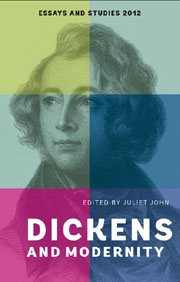Book contents
- Frontmatter
- Contents
- LIST OF ILLUSTRATIONS
- ACKNOWLEDGEMENTS
- NOTES ON THE CONTRIBUTORS
- INTRODUCTION
- 1 THE DICKENS TAPE: AFFECT AND SOUND REPRODUCTION IN THE CHIMES
- 2 DICKENS, SEXUALITY AND THE BODY; OR, CLOCK LOVING: MASTER HUMPHREY'S QUEER OBJECTS OF DESIRE
- 3 TEXTS, PARATEXTS AND ‘E-TEXTS’: THE POETICS OF COMMUNICATION IN DICKENS'S JOURNALISM
- 4 CORPUS STYLISTICS – DICKENS, TEXT-DRIVENNESS AND THE FICTIONAL WORLD
- 5 THINGS, WORDS AND THE MEANINGS OF ART
- 6 DICKENS AND THE CIRCUS OF MODERNITY
- 7 THE OLIVER! PHENOMENON; OR, ‘PLEASE, SIR, WE WANT MORE AND MORE!’
- 8 ‘WOW! SHE'S A LESBIAN. GOT TO BE!’: RE-READING/RE-VIEWING DICKENS AND NEO-VICTORIANISM ON THE BBC
- 9 OUT OF PLACE: DAVID COPPERFIELD'S IRRESOLVABLE GEOGRAPHIES
- 10 AFTERWORD: THE 2012 BICENTENARY
- Index
INTRODUCTION
Published online by Cambridge University Press: 05 February 2013
- Frontmatter
- Contents
- LIST OF ILLUSTRATIONS
- ACKNOWLEDGEMENTS
- NOTES ON THE CONTRIBUTORS
- INTRODUCTION
- 1 THE DICKENS TAPE: AFFECT AND SOUND REPRODUCTION IN THE CHIMES
- 2 DICKENS, SEXUALITY AND THE BODY; OR, CLOCK LOVING: MASTER HUMPHREY'S QUEER OBJECTS OF DESIRE
- 3 TEXTS, PARATEXTS AND ‘E-TEXTS’: THE POETICS OF COMMUNICATION IN DICKENS'S JOURNALISM
- 4 CORPUS STYLISTICS – DICKENS, TEXT-DRIVENNESS AND THE FICTIONAL WORLD
- 5 THINGS, WORDS AND THE MEANINGS OF ART
- 6 DICKENS AND THE CIRCUS OF MODERNITY
- 7 THE OLIVER! PHENOMENON; OR, ‘PLEASE, SIR, WE WANT MORE AND MORE!’
- 8 ‘WOW! SHE'S A LESBIAN. GOT TO BE!’: RE-READING/RE-VIEWING DICKENS AND NEO-VICTORIANISM ON THE BBC
- 9 OUT OF PLACE: DAVID COPPERFIELD'S IRRESOLVABLE GEOGRAPHIES
- 10 AFTERWORD: THE 2012 BICENTENARY
- Index
Summary
On the centenary in 1970 of Dickens's death, his image appeared on the postage stamps of thirteen British Commonwealth countries. For over a decade (1992–2003), Dickens was the face of the British ten-pound note and the image of a cricket match at Dingley Dell from The Pickwick Papers formed its background. As I write this Introduction in 2011 on the eve of the bicentenary of Dickens's birth, new Dickens adaptations, biographies, press stories, events, conferences and exhibitions are already announcing themselves all over the world. Dickens's continued cultural prominence and the ‘brand recognition’ achieved by his image and images seem to suggest that his vision has a certain consonance in the post-Victorian world. But how modern was Dickens? This question gives rise to no simple answer but to a myriad of paradoxes and contradictions. To the general public, Dickens has come to represent all that is not modern; he has become synonymous with a Victorian age defined in opposition to the present. It is notable that though Dickens is the most adapted author of all time for the screen, whereas it is a familiar experience to view ‘modern’ Shakespeare adaptations, there are relatively few Dickens adaptations that eschew costume for contemporary dress and settings; significantly, those that do so are often set and directed abroad. The viewing public likes to fix Dickens in a particular vision of a Victorian period which it associates with ‘the past’ as well as with a distinctive brand of Englishness or Britishness.
- Type
- Chapter
- Information
- Dickens and Modernity , pp. 1 - 18Publisher: Boydell & BrewerPrint publication year: 2012

